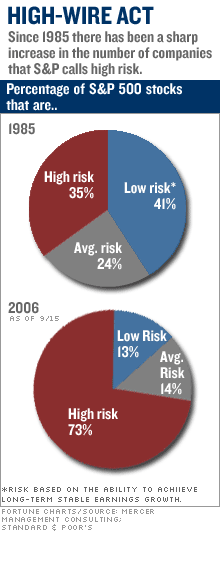|
Managing in chaos The great challenge of our era? Get companies to change quickly enough to survive a world that's crazier and riskier than ever.
(Fortune Magazine) -- Bill Ford finally joined the club just before Labor Day weekend. That's when he became the latest chief executive of a giant corporation to cop publicly to the most fundamental and alarming of business problems: His business model doesn't work anymore. He did it in an e-mail to all of Ford Motor's employees, saying, "The business model that sustained us for decades is no longer sufficient to sustain profitability." Give him high marks for candor, because in corporate life, desperation doesn't get much more naked than that. The chief of one of the world's most storied companies, No. 5 on the Fortune 500, is telling the world that the firm's way of doing business doesn't make money, and he doesn't even know what the new way of doing business should be.
And he's not alone. Ford's lament is the signature cry of our age. Across sectors--retailing, brokerage, software, publishing, computers--business models that produced profits for decades have shut down. In most cases managers aren't sure what the new model will be, but they're absolutely certain it won't have a multidecade lifespan. The trend seems to be accelerating. Besides Ford's (Charts) admission recent weeks saw Viacom (Charts) chief Sumner Redstone abruptly fire CEO Tom Freston, complaining that he hadn't done enough to build a new Net-based business model. Intel (Charts) one of the world's great adapters, announced it was firing 10,500 people. Even Dell (Charts) is having trouble with its formidable direct-selling model, one of the most successful of the past 20 years. How often does a model have to change in today's world? "Until recently, very few companies have had to change ... every three to four years, but now many of them do," says Adrian Slywotzky of Mercer Management Consulting, co-author of business bestsellers The Profit Zone and How to Grow When Markets Don't. "Every eight to ten years--that's heaven today." Greater risk From inside a company, today's world is a maelstrom of changing markets, technologies, customers, and products that are whirling so fast they just can't be ordered in a manager's mind. Look at Standard & Poor's ratings of equity risks, which range from A+ for the least risky companies to D for bankrupt ones. In 1985 about 41% of companies earned the least risky ratings, while 35% were in the high-risk grouping. By 2006 only 13% were highly rated, and 73% were high-risk. That's what economists call a secular shift--a big, broad increase in uncertainty and volatility. The pressure on CEOs and boards is palpable--and executive turnover is on the rise. When Jim McNerny moved over to run Boeing (Charts) last year, the previous firm he ran, 3M (Charts), had to scramble for a replacement; new Ford CEO Alan Mulally departed from Boeing's largest business, returning the favor. Freston's firing has sparked rumors about Brad Grey's future at Viacom subsidiary Paramount. From Heinz, where investor Nelson Peltz is rattling cages, to Big Pharma, where Merck, Pfizer, and most recently Bristol Myers Squibb have seen a changing of the guard, to Dell, where CEO Kevin Rollins is feeling the heat from recent troubles, no one, it seems, is immune. Managing amid the chaos has become the central problem for companies of every kind. It is a predicament that arises from the very nature of today's economy. And the solution requires a retraining not of skills but of mindset and assumptions. The biggest challenge has less to do with corporate strategy or management structures than with the nature of human beings and our instinctive reactions to change. Rocking the foundation Firms that have found ways to survive and thrive in the chaos hold valuable lessons. Paradoxically, many are meeting chaos with chaos, loosening controls, sometimes radically, while guiding the company in innovative ways. Yet even those efforts may lose their effectiveness over time. Today's fast-moving reality may force a rethinking of just how long companies can and should survive. Skeptical about how large a change we're experiencing? Is the business world truly rocking on its foundations? The hard fact: We are going through a transition that will interest historians centuries from now. It's partly a result of globalization, partly the digital revolution and the information-based economy it spawns. By freeing companies from physical assets, it has made them both more flexible and more vulnerable to competitors. Microsoft can get into and out of many businesses--Internet search, online advertising, mapping, electronic payment--at virtually a moment's notice, but so can anybody else. (Indeed, Microsoft itself is now being disrupted by Net-based competitors like Yahoo and Google.) The pattern is old hat by now, yet we still see companies of every kind totally blind-sided by competitors they never saw coming. eBay and its PayPal unit are disrupting credit cards; Google is now trying to disrupt PayPal as well as the whole ad-sales industry. YouTube is disrupting television, and MySpace may next disrupt music, though if you're reading this online in 2008 you're probably laughing, because someone else has undoubtedly disrupted YouTube and MySpace, those Net phenoms of yore. The digital revolution also makes business more chaotic by shifting information and power toward customers. And it changes products in every industry, new or old. Today's cars are essentially computers on wheels. Some credit cards have chips in them. Some greeting cards have chips in them. Guess what some duck calls have in them? Now, what did the makers of any of those things know about computer chips? Nothing, yet their industries may be transformed by them, and more industries will be transformed every day as the costs of computing power, telecommunications, and data storage continue to plunge. So the forecast for most companies is continued chaos with a chance of disaster. The challenge is getting comfortable with it--especially hard because modern corporations were created explicitly to resist chaos. "The idea was to create structure and rules to resist the forces buffeting the business," says David Nadler, a Mercer Delta consultant with long experience counseling organizations on change. "It was great for an era when companies might change every 30 years or more." But what used to be an asset is now a liability. Recipe for internal war Companies that prosper in this frightening environment do so in many ways. Some managers figure a radically changed business world calls for a radically restructured company. The most extreme example of meeting chaos with chaos is probably Semco, the celebrated Brazilian outfit where there are virtually no job titles, a few executives trade the CEO role every six months, and workers set their own hours and choose their managers by vote. Maybe your firm can't do all those things (though it might be useful to ask yourself, Why exactly not?), but decentralization and an anti-control ethos seem to characterize a growing number of successful businesses. No one at W.L. Gore has a job title, to take an example from Fortune's latest list of America's 100 Best Companies to Work For. Another: Any employee of Whole Foods Market can look up anyone else's salary, which sounds like a recipe for internal war. Conventional wisdom says such policies will massively distract an organization, yet in a fast-changing world they seem to have the opposite effect. Former Royal Dutch Shell exec Arie de Geus studied the world's longest-lived companies and concluded that surviving was all about "letting things happen in the margin: allowing activities outside the core business to be set up by not coming down like a ton of bricks on every diversion in which local people seem to believe fervently." Starting up a company with this mentality--which is the way W.L. Gore and Whole Foods began--is a lot simpler than injecting it into an existing enterprise. Consultant David Nadler recalls working with AT&T back when it first began to realize the challenges it faced in a deregulated digital world. "Executives told me they wanted their people to be entrepreneurs and risk takers," he says. "I told them, 'Guess what? People like that don't go to work for the phone company.'" His conclusion: AT&T should have started changing its DNA years earlier. Gene therapy Which brings us to the central issue. Companies aren't really structures or machines or collections of assets. They're groups of people. And while business seems to change at the speed of light, humans in groups haven't changed much in 10,000 years. The most intractable problems of managing in chaos aren't those of structuring the organization or identifying the right model for the future. They are the utterly human problems of getting people in groups to behave in new ways. Some of the reasons are familiar. All change creates winners and losers in an organization, and the caveman part of our brains is still wired to defend against loss above all. So people almost always resist change. An even more profound problem in companies that make changes: saying goodbye. The late Peter Drucker identified the key management challenge of the 21st century as leading change, and he believed the most important policy for doing that was "to abandon yesterday." By yesterday he meant whatever no longer works. Yet abandoning yesterday is excruciatingly difficult. Yesterday is comfortable, and the fact that it used to work inspires hope that it will again. By contrast, trying anything new will always produce problems. So companies nurture yesterday far too long. What's especially insidious, Drucker observed, is that maintaining yesterday is difficult and time-consuming and "therefore always commits the institution's scarcest and most valuable resources--and above all, its ablest people--to nonresults." Which means they're not available to create tomorrow. Yet it isn't hopeless; companies can manage this critical job. One of the greatest examples is still Intel's brave decision long ago to bail out of dynamic random access memory, the product on which it built its early success. More recently, Thomson Financial abandoned newspapers, which had once made it successful, reasoning that newspapers were the past in the Digital Age. Against that background, it's impossible to avoid an upsetting thought: companies will start dying younger. Look at the firms that just disappeared: the old AT&T, Gillette, May Department Stores, all absorbed into other firms. If technologies, products, jobs, and business models are all appearing and disappearing faster than ever, how could companies be any different? We've fully accepted the idea that most jobs don't last long, though that was a traumatic notion 20 years ago. It's time to face a similar reality about companies. In a world where business models change every three or four years, maybe it's foolish to think a company should survive for a century. Perhaps many industries will conduct themselves on the Hollywood model: the right mix of people come together for a few months or a few years and move on. The world of private-equity companies works on this basis today. The idea that our great business institutions may live shorter lives needn't be troubling. With change happening more quickly, businesses that arise and disappear more quickly than they used to could be the best means of serving customers, investors, and employees. If we're in a truly revolutionary business age, it would be crazy to think that more radical change isn't coming. The challenge: finding the will to embrace it. |
|


